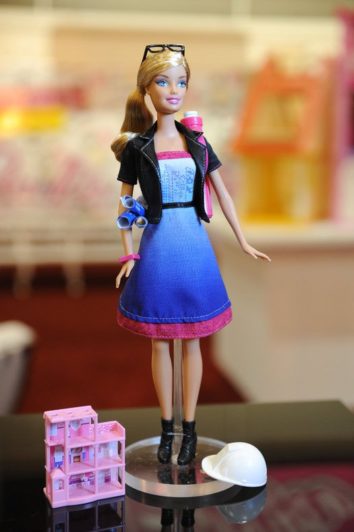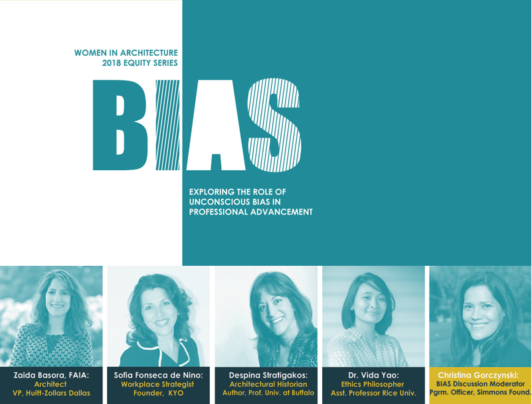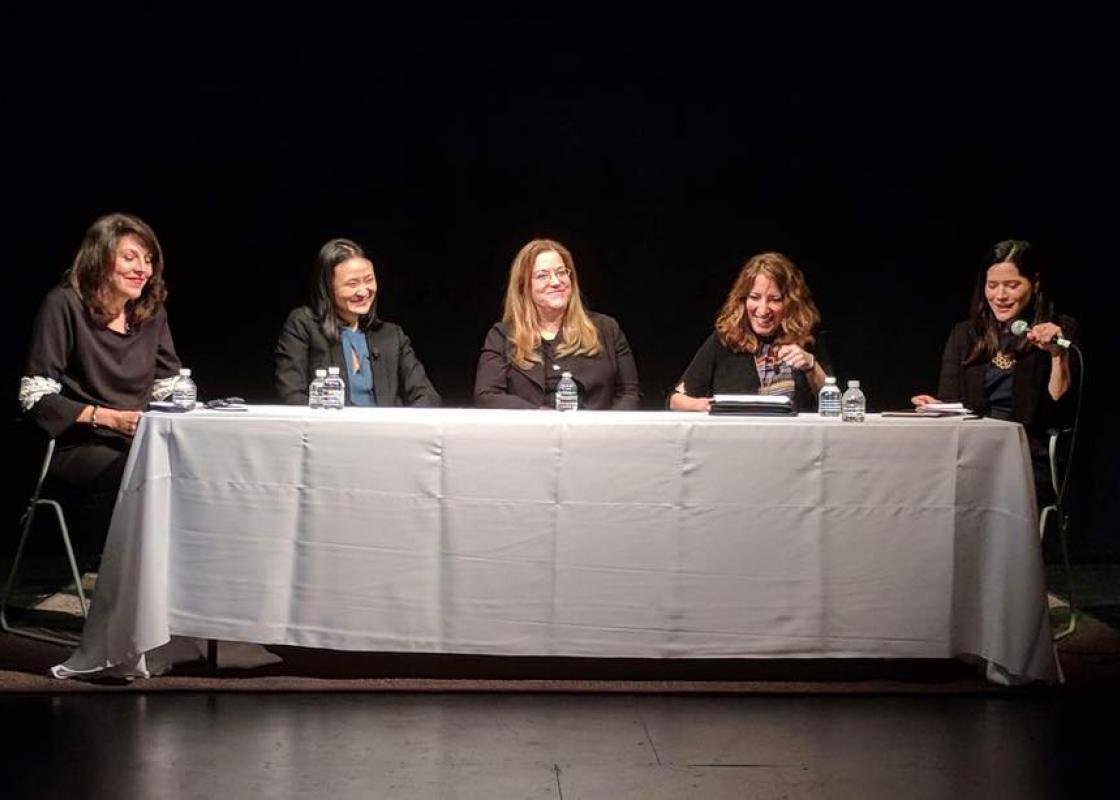Rice Design Alliance is holding its 2018 architecture tour April 7-8 and publishing this series on the theme "Balance: Celebrating Women in Design." Cheryl Joseph is an architectural designer at Titan Homes in Houston.
The launch of the “Me Too” movement in late 2017 has propelled the issue of gender bias in the workplace into daily conversation in many industries including architecture. In an effort to deepen the conversation, the AIA Houston Women in Architecture Committee (WiA Houston) hosted a panel discussion on unconscious bias as part of their first annual Equity Series: BIAS.
The panel discussion brought together the perspectives of four speakers — an architect, an entrepreneur, an architectural historian, and a philosopher. The panel was moderated by an attorney licensed in mediation. All were women.
Dr. Vida Yao, an ethics philosopher and professor at Rice University, explored the different types of biases. A person with explicit bias is knowingly sexist, racist, ageist, etc. Unconscious bias, also known as implicit bias, can mean several different things. A person acts in a biased way because they do not understand different forms of bias or because they are not self-reflective enough to detect their bias. This person is unaware of their pattern of biased behavior and attitudes but, perhaps with education, may change. Truly unconscious bias is the most intractable because it will be hard for the person to identify and understand their bias, even with education. For Yao’s nuanced explication, you can watch the video of her talk here.
Despina Stratigakos, architectural historian and author of Where Are the Women Architects?, illustrated pre-existing biases with her discussion of Architect Barbie, a project she co-created. As part of her early research into what Architect Barbie would look like, she asked University of Michigan students and faculty to develop their own visualizations of the doll. In most dolls by faculty she found what she expected — dolls that put architecture first and suppressed Barbie’s ultra-femininity. The students, however, reversed the order with Barbies that retained the brand’s ultra-femininity while still carrying the hallmarks of the profession – drawing tubes, black glasses, and hard hats. Watch her presentation here.
The final product featured those traditional hallmarks along with features that bridged the gap between professionalism and ultra-femininity — a blue and pink dress with a stitched outline of a skyline under a black, professional jacket and chunky, black boots below.
 Architect Barbie on display at the AIA convention in New Orleans, May 2011. Photo courtesy of Mattel, Inc.
Architect Barbie on display at the AIA convention in New Orleans, May 2011. Photo courtesy of Mattel, Inc.
Stratigakos found in Architect Barbie an unusual vehicle. She jokingly commented that she “didn’t realize that they would be launching a large-scale therapy session for the profession through the doll.” The fact that older generations of architect found the doll to be regressive hinted at the deep fissures of mistrust between generations of architects. The biases experienced and endured by an older generation of women architects were, perhaps, normalized in their psyche, a psyche not shared by some among younger generations of women architects.
The quip “I don’t do copies or coffee” elicited chuckles across the audience attending the panel. Zaida Basora, registered architect and AIA fellow, reiterated the gendered roles imposed on women in the workplace time and time again. Women often pick up an unbalanced share of administrative work in the office such as answering phones and making copies. Women are also often called out as being "too ambitious" or "too vocal" compared to their counterparts, even as the male-dominated industry creates an environment where women are often the only female voice in the proverbial room. Moderator, Christina Canales Gorczynski, asked every woman who has ever found themselves being the only gender representative in the room to raise their hand and then asked men about the equivalent experience. The difference in the number of women who raised their hands compared to the men drove home how male-dominated is the architectural profession. In such an environment, Basora implored the need for women to help one another. “Women are women’s worst enemies; we need to learn how to support each other.” Watch her presentation here.
Sofia Fonseca de Nino, entrepreneur and founder of KYO Consulting, told a story that drew together many of the points made by the panel. Soon after graduation from Harvard, de Nino was asked by a male colleague not to talk during a presentation but to instead stay in the back of the room. Shocked, de Nino felt the effects of this treatment for years before confronting the man. He cried and apologized, demonstrating the type of unconscious (implicit) bias that can be made conscious and thereby mitigated, which Yao described. Nearly 25 years later, however, de Nino found herself in another presentation and being asked by a woman 12 years her superior not to talk and stay in the back of the room. This time, de Nino left the firm and started her own. Watch her presentation here.
 Guests of Unconscious Bias Panel, March 2018. Courtesy of WiA Houston.
Guests of Unconscious Bias Panel, March 2018. Courtesy of WiA Houston.
Apart from discussing the perception of and barriers to equity in the current climate of bias, the panelists also reviewed solutions. Championing the education of men and women alike, the panelists cited the need for support from allies and partners in the workplace to effectively foster workplace inclusivity. Zaida Basora specifically spoke of the importance to “mentor young men as we do young women.” An all-gender outreach ensures that young men will be mentored to understand their unconscious bias before it develops into their norm.
About 90 percent of the 175 guests registered were women — a far higher rate than found at every level of the architecture profession. The tide is changing, however, with nearly 2 in 5 newly licensed architects being women (2017 National Council of Architectural Registration Boards). The conversation continues in Houston. The second part of WiA Houston’s Equity Series was a hands-on workshop on March 29 that provided tools for improving workplace inclusivity. The upcoming Rice Design Alliance architecture tour, highlighting homes that have been designed by or envisioned by women, is April 7-8.










